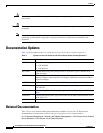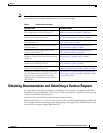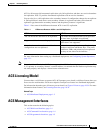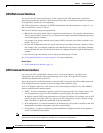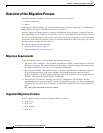
CHAPTER
1-1
User Guide for Cisco Secure Access Control System 5.3
OL-24201-01
1
Introducing ACS 5.3
This section contains the following topics:
• Overview of ACS, page 1-1
• ACS Distributed Deployment, page 1-2
• ACS Management Interfaces, page 1-3
Overview of ACS
ACS is a policy-based security server that provides standards-compliant Authentication, Authorization,
and Accounting (AAA) services to your network. ACS facilitates the administrative management of
Cisco and non-Cisco devices and applications.
As a dominant enterprise network access control platform, ACS serves as an integration point for
network access control and identity management.
ACS 5.x provides a rule-based policy model that allows you to control network access based on dynamic
conditions and attributes. The rule-based policy is designed to meet complex access policy needs. For
more information on the rule-based policy model in ACS, see Chapter 3, “ACS 5.x Policy Model.”
Within the greater context of two major AAA protocols—RADIUS and TACACS+—ACS provides the
following basic areas of functionality:
• Under the framework of the RADIUS protocol, ACS controls the wired and wireless access by users
and host machines to the network and manages the accounting of the network resources used.
ACS supports multiple RADIUS-based authentication methods that includes PAP, CHAP,
MSCHAPv1, MSCHAPv2. It also supports many members of the EAP family of protocols, such as
EAP-MD5, LEAP, PEAP, EAP-FAST, and EAP-TLS.
In association with PEAP or EAP-FAST, ACS also supports EAP-MSCHAPv2 and EAP-GTC. For
more information on authentication methods, see Appendix B, “Authentication in ACS 5.3”.
• Under the framework of the TACACS+ protocol, ACS helps to manage Cisco and non-Cisco
network devices such as switches, wireless access points, routers, and gateways. It also helps to
manage services and entities such as dialup, Virtual Private Network (VPN), and firewall.
ACS is the point in your network that identifies users and devices that try to connect to your network.
This identity establishment can occur directly by using the ACS internal identity repository for local user
authentication or by using external identity repositories.
For example, ACS can use Active Directory as an external identity repository, to authenticate a user to
grant the user access to the network. For more information about creating identities and supported
identity services, see Chapter 8, “Managing Users and Identity Stores.”








